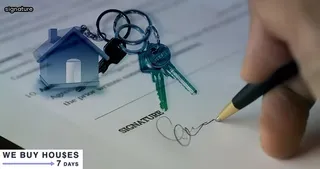Filing a Maryland Quit Claim Deed is an important step when transferring ownership of real estate. This document serves as proof of ownership and must be officially filed with the county court in order to be valid.
Understanding Maryland Quit Claim Deed laws and the process for filing is key to completing a successful transfer. To begin, it’s important to understand what a quit claim deed is, its purpose, and how it functions in transferring real estate ownership in Maryland.
A quit claim deed is a legal document that transfers ownership of property from one individual or entity to another without making any warranties or guarantees on behalf of the grantor (the party transferring the property). The grantor simply “quits” any claims they have to the property being transferred.
This document does not require an appraisal or inspection, nor does it guarantee clear title. It must also meet certain requirements under Maryland law, such as including all necessary parties names and signatures in order for it to be legally binding.
Once completed, the quit claim deed must be officially recorded with the county court in order for the transfer of ownership to take place. Knowing how to file a Maryland Quit Claim Deed correctly will help ensure your real estate transaction is carried out efficiently and properly so you can rest assured that your new property has been successfully transferred into your name.

A Maryland Quitclaim Deed is an important legal document used to transfer the title of a property from one person to another. It is commonly used when transferring ownership of a house or real estate, and should be filed with the local Register of Wills following the proper procedure.
It is important to understand the basics of filing a Quitclaim Deed in Maryland in order to ensure that the transaction is done correctly. This document must include information about the grantor and grantee, such as their full names, addresses, and contact information.
The deed must also include a detailed description of the property being transferred, including its address and legal description. After all necessary information has been provided and the deed has been signed by both parties, it must be notarized before being filed with the local Register of Wills.
Once this process is complete, it is important to obtain certified copies of the deed for record keeping purposes. Filing a quitclaim deed in Maryland requires attention to detail and knowledge of the process; however, understanding how to do so properly can save time and money in the long run.
Filing a Maryland quit claim deed is an important step in transferring real estate or houses. To ensure the transfer is legally recognized, it's important to follow the state's requirements for writing and filing the deed.
The first step is to find out which county requires the deed to be filed in - as this varies from one county to another. Next, obtain a blank quit claim deed form from the courthouse or online.
Once you have filled out all of the required information on the form, have it signed by both parties involved in the transaction. After that, the completed document needs to be notarized by a certified Notary Public and then submitted with additional paperwork such as proof of identity and property ownership documents to your local county recorder’s office.
If you need help completing any of these steps, contact your attorney or local real estate agent for assistance. Following these steps will ensure that your Maryland quit claim deed is properly written and filed so that it can be legally recognized in court should future disputes arise.

Filing a Maryland Quit Claim Deed is an important process when it comes to transferring the ownership of houses and real estate. It can be a complicated task, so understanding the steps is essential.
First, you must obtain a blank Maryland Quit Claim Deed form, either from your county courthouse or online. Next, fill out the form in its entirety with information about the grantor (current owner) and grantee (new owner).
You must also include details about the property such as address, legal description and deed book number. Once complete, have all parties involved sign the deed and have their signatures notarized for authentication.
After this step is finished, take the deed to your local county recorder's office in order to officially transfer ownership of the property. The recorder will then record the deed into public records for legal proof of ownership transfer.
It's important to note that tax implications may apply when filing a Maryland Quit Claim Deed; check with your financial advisor or local government authority for more information on potential taxes related to this process.
Filing a Maryland Quit Claim Deed for Houses and Real Estate can be a daunting process. Fortunately, by using a free printable template, the entire process can be simplified significantly.
The template provides an effective way to create a valid quit claim deed that is recognized by the state of Maryland. It starts with basic information such as the names of the grantor and grantee, the legal description of the property, and any additional notes or considerations needed.
This is followed by instructions on how to properly fill out the form and sign it in front of witnesses or notarize it according to local laws. The template also includes helpful tips on gathering all necessary documents required for filing with the county recorder's office.
With this valuable resource, anyone can quickly learn how to file a Maryland Quit Claim Deed for Houses and Real Estate in no time.

Completing a Maryland Quitclaim Deed is an important step for transferring ownership of real estate, such as houses and other properties. A Quitclaim Deed is a legal document that transfers ownership from one person to another without guaranteeing the title or warranting any interest in the property.
It's important to understand the benefits of filing a Maryland Quitclaim Deed when transferring property. This allows individuals to quickly transfer title without having to go through lengthy court proceedings, making it more affordable than other forms of deed transfers.
Additionally, Maryland Quitclaim Deeds can be used with different types of properties, including those with mortgages or liens. The process is relatively simple, as long as all parties involved are in agreement about the transfer of ownership and all paperwork is filled out correctly.
Furthermore, filing a Quitclaim Deed does not require an attorney or title company to be involved since it does not guarantee or warrant any interests in the property being transferred. Understanding the benefits of completing a Maryland Quitclaim Deed can help make transferring real estate easier and less expensive for everyone involved.
In Maryland, the grantor and grantee in a quitclaim deed must both be of legal age (18 or older) and sound mind, with the grantor owning the rights to the property in question. The grantor must sign the deed in front of a notary public, while the grantee can sign it without one present.
It is important to note that if multiple parties are involved in transferring ownership, all of them must appear before a notary. Furthermore, any further documents required by law must also be signed and notarized by both parties involved.
When completed, the deed should be filed with the Maryland Department of Assessments and Taxation for recording. It is important to keep copies of all documents associated with filing as proof that ownership has been transferred.

When considering how to file a Maryland Quitclaim Deed for Houses and Real Estate, it is important to understand the different types of property and how they relate to this legal document. There are several categories of property that can be passed through a Quitclaim Deed, such as real estate, mobile homes, vehicles, watercrafts and other personal assets.
In order for a Quitclaim Deed to be legally binding in Maryland, it must include certain elements. These include the names of the parties involved in the transaction, an accurate description of the property being transferred and a notarized signature from both parties.
Additionally, depending on the type of property being transferred, there may be additional requirements such as special forms or licenses. Understanding these different types of property and how they relate to Maryland Quitclaim Deeds is essential for properly filing one.
When you file a Maryland Quit Claim Deed for houses and real estate, it is important to understand the tax implications of completing this process. Depending on how the deed was filed, there may be certain taxes that need to be paid.
This could include filing fees, stamp taxes, transfer taxes and recordation taxes. Additionally, the type of property being transferred (such as residential or commercial) can also affect the amount of taxes due.
It is important to contact your local tax office to get an understanding of what type of taxes may be applicable after completing a Maryland Quit Claim Deed. Furthermore, if you are transferring ownership between family members or spouses, there may be certain exemptions available that could reduce the amount of taxes due.
Understanding these implications ahead of time can help ensure you are prepared when it comes time to file your deed and make any necessary payments.

If you have discovered that there is incorrect information on your Maryland Quit Claim Deed, it is important to take action to rectify the situation. The first step is to contact a lawyer or legal professional who specializes in real estate and property law in order to understand what your next steps should be.
Depending on the situation, the legal professional may recommend filing an amendment or correcting deed in order to make any necessary changes. This document must then be signed by all parties listed on the deed, notarized, and filed with the appropriate county clerk's office.
It is also possible that you may need to pay a fee when submitting your corrected quit claim deed. Understanding what needs to be done in order to make sure all pertinent information is accurately reflected on your Maryland Quit Claim Deed can help avoid future issues and misunderstandings involving your house or other real estate property.
Before filing a Maryland Quit Claim Deed for houses and real estate, it is important to consider some key points. First, you should familiarize yourself with the deed laws in your county of residence.
Additionally, before completing the deed, be sure to obtain all pertinent information about the parties involved such as names, addresses and contact information. You will also need to establish ownership of the property by obtaining a copy of the title from either the seller or an escrow company.
Furthermore, make sure that both parties are in agreement with all terms listed on the deed and have signed it accordingly. Finally, once everything is complete and verified, you can file your Maryland Quit Claim Deed with the appropriate county office.

Filing a Maryland Quit Claim Deed for Houses and Real Estate requires the effective execution of acknowledgements to ensure that all parties involved are aware of their rights, responsibilities and roles. When executing an acknowledgement, the individual signing must swear or affirm that they understand the contents of the document and that it is true and correct.
The document must be signed in front of a notary public, who will administer an oath or affirmation as to its truthfulness. The notary public will then sign the document along with two witnesses who also understand the contents of the document.
These witnesses must sign in front of each other, which is known as “jurat”. Once all signatures have been obtained and notarized, it is important to make sure copies are kept for future reference and record-keeping.
In addition, any additional documents related to the MD Quit Claim Deed should also be filed with your county's clerk office for official record keeping purposes. Following these steps will ensure that you have properly executed acknowledgements when filing Maryland Quit Claim Deeds for Houses and Real Estate.
Once you have completed your Maryland quit claim deed (QCD) transaction, it is important to follow the necessary steps to ensure that the transfer of real estate is valid. First, make sure that you have received a receipt from the grantee confirming the acceptance and agreement of the QCD.
This document serves as evidence of the transfer and should be kept for your records. Second, submit a copy of the completed QCD along with a copy of the receipt to your county’s Circuit Court Clerk office which will file and record the deed in their records.
Once filed, you can obtain a certified copy of the document from the clerk's office which serves as further proof that you successfully transferred ownership. Finally, if applicable, any real estate taxes must be paid and all other documents related to previous transactions must be updated with new owner information.
Taking these final steps after completing a QCD ensures that your real estate transaction will be properly recorded in Maryland state records.

When researching Maryland Quit Claim Deeds (QCDs) related to houses and real estate, there are many resources available that can provide helpful information. It is important to understand the associated legal requirements that come with this type of transaction.
The Maryland Department of Housing and Community Development provides a number of documents, such as forms and Frequently Asked Questions (FAQs), that can be very useful in understanding the process. Additionally, there are several websites dedicated to providing detailed explanations of the process for filing a QCD in Maryland.
Legal experts have also written articles on the subject, which can provide additional insights into the process. Finally, local government offices may offer guidance or assistance when filing a QCD in Maryland; contact information for these offices can typically be found online or through other resources.
With these resources at one's disposal, it is possible to gain a better understanding of how to file a quit claim deed in Maryland for houses and real estate.
Finding legal help regarding Maryland Quit Claim Deeds (QCDs) can be a complex process. It is important to find an experienced attorney who specializes in real estate law and understands the intricacies of filing a QCD in Maryland.
There are several resources available for individuals looking for legal assistance. The Maryland Bar Association can provide referrals to qualified attorneys and provide information about the relevant laws, regulations, and best practices.
Additionally, the Maryland Department of Assessments and Taxation has a website that provides helpful information on how to file a QCD as well as an online form to fill out. Other online resources exist such as various websites dedicated to providing advice on filing a QCD in Maryland.
Finally, friends or family who have previously filed a QCD may be able to provide personal recommendations for an attorney or other professional who can help with the process.

Filing a quit claim deed in Maryland can be a confusing process, especially for those without prior experience. Although the general process is similar to filing in other states, there are some nuances specific to Maryland that should be understood before going forward.
This article will answer some of the most common questions about filing a Quit Claim Deed (QCD) in Maryland so you can feel more confident when it comes time to do so. One key point to remember is that while QCDs are primarily used for transferring property between family members, they can also be used to transfer any kind of real estate or houses.
When filling out the form, you must include all parties involved as well as their contact information and signatures. It's important to note that all parties must sign the document before submitting it to the county clerk's office for final approval.
Additionally, make sure to obtain copies of the document for your records and provide proof of ownership such as a copy of the title or deed. Lastly, be aware that fees may apply depending on how much property is being transferred so plan accordingly.
Filing a Maryland Quit Claim Deed (QCD) is an important step when transferring the title of a property or real estate. A QCD is a type of deed used to transfer ownership from one person to another and it is popular in Maryland due to its simplicity and efficiency.
This form can be used to transfer any kind of real estate, such as houses, mobile homes, recreational vehicles, condominiums, apartments, commercial buildings, vacant land, and more. When filing a QCD in Maryland, it is essential to make sure that all parties involved are aware of the process and that all forms are accurately completed and filed with the local county clerk.
Additionally, it is important to understand that the deed will be recorded in public records after the transaction has been completed so there will be a public record of the transfer. Knowing how to properly file a Maryland Quit Claim Deed is key for those looking to transfer property in this state.

FormSwift offers a convenient way to access all forms necessary for filing a Maryland Quit Claim Deed for houses and real estate. With the mobile app, users can quickly and easily find the right form, fill it out, and file with ease.
The app provides step-by-step instructions on how to properly complete the form and even allows users to save their progress as they go. All forms are securely stored in the cloud so that users can access them at any time and from any device.
Whether you're an experienced professional or a first-time user, FormSwift's mobile app makes it easier than ever to file a Maryland Quit Claim Deed for houses and real estate. Download the app today to get started!.
A quit claim deed is a legal document used to transfer ownership of real estate or a house in Maryland. In order for it to be valid, certain requirements must be met.
The grantor (seller) must sign the document in front of a notary public, and the deed must describe the property accurately. Furthermore, all parties involved must provide their names, addresses and marital status.
Additionally, the deed must include specific language and be written on an 8 1/2 by 11 inch paper with no staples or other obstructions. For the quit claim to be recorded with the county clerk's office and become effective, it needs to require two witnesses who are over 18 years old as well as one notary public who verifies that the signatures were signed freely and voluntarily.
Finally, it must include a legal description of the property being transferred, as well as details about any outside liens or encumbrances that already exist on it.

A quitclaim deed in Maryland is relatively inexpensive. The cost varies depending on the county, but most counties charge a fee of around $20 for the filing of a quitclaim deed.
It is important to note that the fee does not include any costs associated with title searches or legal advice, which may be necessary depending on the type of transaction. Additionally, there may be additional taxes or fees that are required to record the deed with the local county clerk.
To complete a quitclaim deed in Maryland, you will need to provide information about both parties involved and must sign it in front of a notary public. After all of the information has been gathered and signed, it must then be filed with the local county clerk's office where it can be recorded and officially become part of public record.
Filing a quitclaim deed in Maryland is an easy and affordable way to transfer real estate between two parties.
A quitclaim deed is a legal document used to transfer property from one party to another. In Maryland, it can be used to transfer residential and commercial real estate.
The process for filing a Maryland Quit Claim Deed is relatively straightforward, but there are some important steps that need to be followed in order to ensure that the deed is properly filed. In order to file the deed, the parties involved must first sign and notarize the document.
Once the document has been signed and notarized, it will then need to be filed with the appropriate county clerk's office in Maryland. It is important that all of the necessary paperwork is completed before filing so that any potential issues can be addressed prior to submission.
After the deed has been filed with the county clerk's office, it will become legally binding on both parties involved in the transaction. By understanding how to file a Maryland Quit Claim Deed for houses and real estate, individuals can ensure that their transactions are properly recorded and that their rights are protected under state law.
Anyone can prepare a deed in Maryland, so long as they have the correct information and documents. The most common type of deed used for transferring real estate ownership is the Quit Claim Deed.
Before you can file a Quit Claim Deed in Maryland, you will need to gather certain information and documents. You will need the name of the current owner, a legal description of the property, and an estimate of the sale price.
You may also need to provide proof that all taxes and liens owed on the property have been paid in full. Once you have gathered all of this information, you can then complete your Quit Claim Deed form.
Make sure to include signatures from both parties involved in the transfer of property ownership - both buyer and seller - along with any witnesses or notaries needed for authentication purposes. Finally, you must deliver your completed Maryland Quit Claim Deed form to your local land records office for filing and recording.
By following these steps, you can easily learn how to file a Quit Claim Deed in Maryland for houses and other real estate transactions.
A: To complete a quit claim deed on a house in Maryland using a General Warranty Deed, you will need to obtain the Title Deeds of the property and prepare a document that states your intention to transfer the ownership of the property. This document should include details of yourself and the recipient, as well as an explanation of your conveyance and warranty. After filling out all necessary information, you must sign the deed in front of witnesses or a notary public, who will then sign off on it to make it legally binding.
A: A married couple in Maryland can transfer ownership of their home to a Living Trust with a Trustee using a Quit Claim Deed by completing the deed, signing it before two witnesses, and having it notarized. The deed should be recorded with the Clerk of the Circuit Court in the county where the property is located.

A: In Maryland, a General Warranty Deed should be used when two or more people own a house as Tenants in Common, Joint Tenants, or Tenancy by the Entirety.
A: In order to transfer ownership of a house in Maryland via a quit claim deed, the deed must be signed by all parties and notarized. The deed must then be filed with the Clerk of Court in the appropriate jurisdiction according to Maryland real estate laws. Additionally, any applicable taxes and fees must be paid before the transfer can take place.
A: To transfer ownership of a house in Maryland using a Quit Claim Deed, you must provide the deed to the local Circuit Court Clerk's office and pay the relevant filing fees. The deed must be signed by all parties involved in the transaction and notarized before it can be accepted. The deed should also include a General Warranty Deed if more than two people own the house as Tenants in Common, Joint Tenants, or Tenancy by the Entirety.

A: To transfer property ownership of a house in Maryland using a quit claim deed, you must complete the deed form and sign it in front of two witnesses or a notary public. The deed should then be recorded at the Register of Wills for the county where the house is located. Additionally, any applicable real estate taxes must be paid prior to transferring ownership.
A: To transfer ownership of a house in Maryland via a quit claim deed, the deed must be signed and dated by the grantor, notarized and filed with the Maryland Department of Assessments and Taxation. The filing fee is $80.00.
A: To transfer ownership of a house in Maryland using a Quit Claim Deed, it is necessary to draft the deed and have it notarized. The deed must include the names of all parties involved in the transaction, the address of the property being transferred, and must be signed by both parties. It must then be recorded with the Clerk of Court’s Office in the county where the property is located.

A: The quit claim deed must be signed by all parties, notarized, and then recorded with the land records office in the county where the property is located. Once recorded, it will become part of the public record.
A: To transfer ownership of a house in Maryland using a Quit Claim Deed, the deed must include the grantor and grantee's names, the purpose of the transfer, and a legal description of the property. The deed must also be signed by both parties in front of witnesses and then notarized. Once completed, it should be filed with the local county court where the property is located.
A: The process for transferring Legal Title and Property Title of a house in Maryland using a Quit Claim Deed is relatively simple. First, you must prepare the deed. This can be done by either having an attorney create it or creating it yourself. Next, the deed must be signed by all parties involved in the transaction. Finally, the deed must be recorded with the county clerk's office. Once recorded, the Legal Title and Property Title are transferred to the new owner.

A: In Maryland, a Quit Claim Deed is typically used for transferring legal title between two or more people who own a house as Tenants in Common, Joint Tenants, or Tenancy by the Entirety. The deed must be signed and notarized in the presence of a witness according to the Maryland Real Estate Laws. The deed must then be filed with the Register of Wills office in the county where the property is located along with any required filing fees.
A: To transfer ownership of a house in Maryland using a quit claim deed, you must file the deed with the Clerk of the Circuit Court in the county where the property is located. The deed must also be notarized and include an accurate description of the property being transferred. Additionally, all parties must sign and date the deed for it to be valid.
A: In order to transfer ownership of a house in Maryland using a quit claim deed, it must be notarized, signed by all parties, and recorded at the local Register of Wills office. Additionally, the deed must include specific language such as "I hereby release my interest" and list the exact property description.

A: Maryland Quit Claim Deed Forms may be obtained from the Maryland Register of Wills, the Maryland Department of Assessments and Taxation, or online resources. It is important to review the Maryland Real Property Code for any requirements and restrictions when using a quit claim deed for transferring ownership interest in a house.
A: The Maryland State Bar Association offers resources to help with the completion of a quit claim deed, as well as access to local attorneys who can provide more detailed assistance.
A: In order to obtain a Maryland Quit Claim Deed Form, you must visit the website of the Maryland Real Estate Commission or contact an attorney who specializes in real estate law.